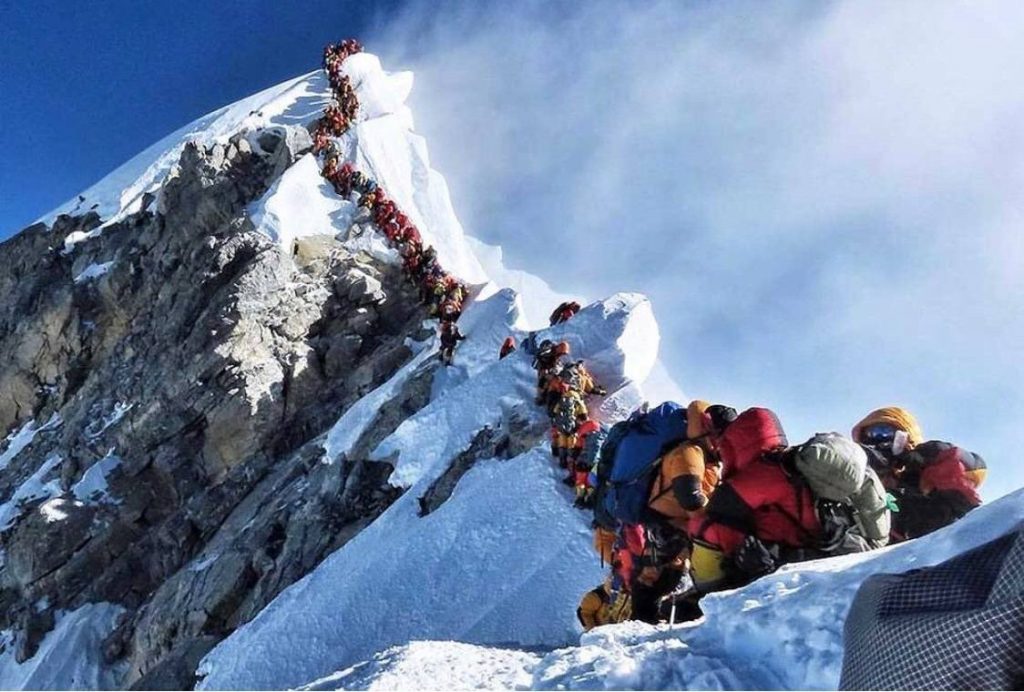The tallest mountain of the world, Mount Everest, has become a victim of human hubris. Over the years, as mountaineering has turned into an increasingly popular activity for adventure seekers, the number of people summiting the Everest has grown considerably. The long queue of people waiting to climb the peak in the short window of good weather, generally found in the month of May, is lengthening with each season. Although the authorities in Nepal claim that they have taken measures to control the crowd of climbers to the Everest, fatalities among mountaineers tell a different tale. It is said that the Nepalese government has given one of the highest number of permits this year, irrespective of the experience or health condition of the climbers. At the same time, the competition among tour operators to pile up inexperienced tourists on the most treacherous journey in the world, where only the most experienced climbers were earlier visible, is definitely a recipe for disaster. Over commercialization of Everest has not only adversely affected serious climbers’ efforts but has also endangered and taken the lives of many climbers such as Kalpana Dash.
Today, the costs of climbing the mountain have gone down, as permits and equipment have become cheaper. The result is a crowd of unruly amateurs jostling with experienced climbers at 29,000 feet, where there is no room for error. To ascend the top, climbers drop every kilo of equipment that they can and take with them just enough cans of compressed oxygen to summit and come down. At such a time, a delay of even an hour draws the thin line between life and death. These delays are more common now because of the jam created by numerous climbers. Professionals say that thinking straight at that altitude is hard. This could make people behave erratically and pose dangers to others.
This season, four Indians, including Kalpana, were among the 10 mountaineers who lost their lives or have gone missing trying to scale Everest. A total of 381 mountaineering permits were given this spring, a record number. Each permit for climbing from Nepal fetches $11,000 for the government. It is also alleged that the Nepali government, in a bid to commercialise the Everest, has turned a blind eye to mismanagement by tour companies who are ever ready to take short cuts where equipment and safety is concerned. This is an indicator of blatant corruption by the Nepal government which remains defiant and unapologetic. Interestingly, the director general of Nepal’s Tourism Department Danduraj Ghimiri when asked by media persons about the large number of deaths that took place on the mountain said that the fatalities happened not because of crowds but because of fewer good weather days. He also added that the government has no desire to decrease the number of permits in future. Apart from bureaucratic and tour companies’ corruption, the underlying desire of the country’s government to increase foreign exchange earnings from tourism is clearly visible. Once the authorities officially decide to take negative actions, loss of lives becomes collateral damage.
Another record was set when 200 climbers ascended the summit in a single day recently. While each climber might add to their personal ambitions and list of achievements by scaling the Everest, the bigger loss is being ignored.
The Himalayan region, also known as the third pole, is a victim of increased human activity. The flashflood in Uttarakhand, which swept away a large number of illegal constructions and other such human interventions in Kedarnath was an indication of changing climate in this mountain range. Earlier, Ladakh had witnessed such a phenomenon and again human intervention was reported to be behind the catastrophe.
According to a United Nations report for 2012, more than 26,000 people had visited the Everest region. That number is bound to have risen manifold now. The difficult conditions on the Everest often force mountaineers to discard items that are of no critical importance to their expedition when a situation arises. The quantum of garbage that has been dumped on the Everest was evident from the fact that 3,000 kilograms of such discarded material was removed from the peak under a clean-up initiative in recent times. These figures are only growing.
With each new mountaineer summiting the Everest, not only the mountain but also the entire region comes under pressure. The lure of adventure will only pull more and more thrill seekers to the Everest. But unless numbers are moderated by some means, an ecologically fragile region will be lost forever. The repercussions of this loss could be devastating.
